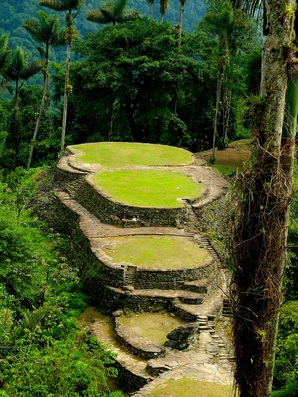 La Cuidad Perdida
La Cuidad Perdida Santa Marta & DumPster Kitty
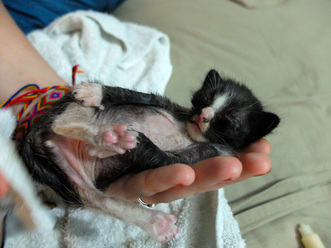 TINY guy
TINY guy  La Cuidad Perdida La Cuidad Perdida After our time in San Gil we were ready to head north to the Caribbean and spend some time lounging on a beach, but not before earning it. We arrived in Santa Marta early in the morning and settled into a hostel near the main market area. At first glance the city was pretty terrible: smelled of urine and rotting garbage mixed with thick black car exhaust, noisy vehicles, sketchy people, etc. I had no interest in walking around so after inquiring into “La Ciudad Perdida” (the Lost City) five-day trek through the jungle, I decided to relax and read a book for the rest of the day. Santa Marta & DumPster Kitty TINY guy TINY guy Andrew went to the bank machine and for a little walk around our area. I had expected him to take longer but after 10 or 15 minutes he barged into the room panicking, with something tucked away in his shirt. At first I thought it was a mouse or a small rat, Andrew just mumbled that he had found it screaming on a sidewalk and could barely explain that no one seemed to care and someone made fun of him for picking it up! It was a TINY kitten. Couldn’t have been more than 4 or 5 days old, with eyes still closed and one of them swollen to half the size of its head. Its hair was thick with dirt and smelled like human urine! Our hearts broke and we didn’t know what to do. Feeling like this kitten urgently needed some food, we left the hostel in search of a veterinarian. It took us far too long to find one but we eventually did after wandering through nasty smelly sweaty streets and market stands. We bought a container of kitten milk powder that you just add water to and a syringe we could use to try and feed him. We hurried back to the hostel and sterilized the syringe. Using a damp towel I cleaned the kitten as best I could while Andrew mixed some milk. It took some time to convince the kitten to eat from the syringe, but with patience we got the job done.
4 Comments
Loving Colombia so far! We arrived in Bogotá after a 16 hour journey, flying from Buenos Aires through Lima (and staying overnight in the airport). We landed fairly early in the day and were settled into Hostel Sue Candeleria in the La Candelaria district (the more touristy and unfortunately more sketchy area). It was federal election day and the day after Colombia's first World Cup win (and subsequent celebratory rioting) so Bogotá was a bit rowdy. We asked a couple of military guys at the airport if it was safe to hang out in Bogotá during the election and how things were going, and they just said “todo tranquilo, hay muchas policías en las calles, esta muy seguro” (everything is good, there are many police in the streets, it is very safe) – that sounded pretty good so we decided to go for a little walk around. 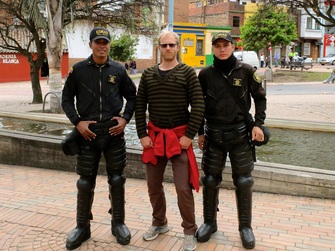 Bogotá police in their skateboarding gear Bogotá police in their skateboarding gear We intended to try and get to Plaza Bolívar (the main square) but never made it that far because the police had put up barricades, likely to stop people from gathering in crowds. We just wandered around La Museo de Oro (the Gold Museum) listening to the street music, watching the vendors selling all kinds of delicious fried or sugar-coated snacks and, of course, giving trying some of them a try. I had a version of the delicious Alfajor from Argentina (Argentina's version is a bazillion times better) – this one was just some plain crispy wafers with a bunch of dulce de leche (thick caramel sauce) in between, mmmmm. I had eaten most of it but had maybe three or four bites left when a happy looking (possibly homeless) guy asked me for some money. Instead, I gave him the rest and he happily thanked me and wandered away, dancing and singing. Things seemed OK in the streets; there were several police and military people just hanging around and patrolling everywhere, with their massive guns at their sides. While some people may find that comforting, I found it unnerving.
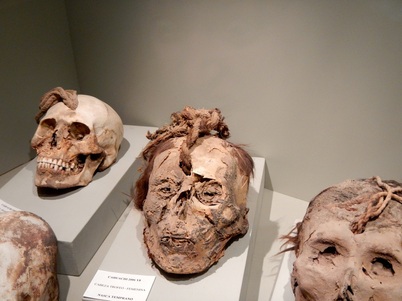 Something about this photo gives me the heebie-jeebies Something about this photo gives me the heebie-jeebies Shamans, medicinal plants, earthquakes, ancient cities, mysterious symbols; Peru really is the most diverse and magical country we have been to so far! Since this is our first visit to Peru (though likely not our last) we decided to go a bit more mainstream than usual and visit the recommended sites along the well-known "Gringo Trail", taking us through all of the major attractions of the country, starting with Lima. To start out on our route we headed via airplane from Iquitos to Lima, in order to save a week or more of time (the other option was another multi-day cargo boat from Iquitos since it has no road access, followed by a 24+ hour bus ride). We didn't spend much time in Lima before departing to Pisco to visit the Ballestas Islands and Paracas National Reserve, and to unexpectedly experience a 5.7 magnitude earthquake while face-timing with Donna and Jim, Andrew's parents. The next stop on the Gringo Trail was Nazca where we saw for ourselves the infamous Nazca Lines and learned a lot about the ancient cultures that inhabited the area between 100bc and 800ad, and then spent the next few days barfing due to the horrific flight over the lines and/or some bad food or water, who knows what. After Nazca was Arequipa, the second most populous city in Peru and the hub to get to the beautiful Colca Canyon (but we decided not to go there since it was a bit far and really expensive). Finally, we arrived in Cusco, our base for some intense Shamanism and of course, to visit Machu Picchu. Next and last on the list (heading out this afternoon via bus) will be the town of Puno where we can visit Lake Titicaca before crossing the border into Bolivia. We can really see why so many people travel this route: the diverse beauty and culture have taken our breath away almost every day since we have arrived. Gringo Trail - click on the icons for informationIquitos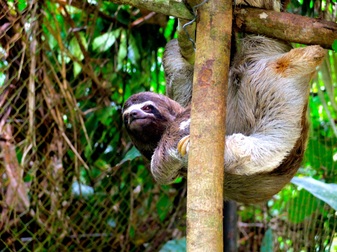 Chili sloth Chili sloth Following our insane Rio Napo trip we spent a couple of days exploring the incredibly loud Amazonian city of Iquitos. There were hardly any cars or trucks in the city, but thousands of moto-taxis (converted motorbikes with carriages on the back), thus the very noisy streets. We have come to realize, however, that almost everywhere in South and Central America so far the people seem to need noise at all hours of the day. You can't help but wonder if they purposfully design the bikes to be extra loud!
On one day while our muuuuuuch needed laundry was being done we wandered around the Belen Market, where one may find almost any kind of medicinal plant (or animal for that matter) you can think of. Of course, as is always wise while wandering in local markets, we only took out our camera a few times and made sure that not many people saw us with it, and we left anything else of any value back at the hostel. 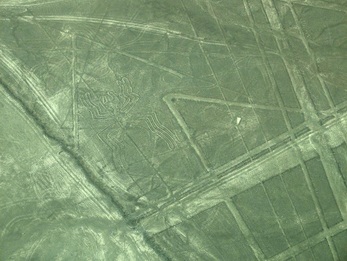 Nazca Lines, including a "spider" figure Nazca Lines, including a "spider" figure The more we see and do in Peru, the more we’re in awe by the magic and mystery that can be found around every corner. It seems like just about every place we visit has some new enchantment to offer, be it the colourful designs covering the traditional clothing, the continuing belief in traditional spiritual and medicinal practices, or the archaeological remains of ancient civilizations. Nazca is certainly no exception to this, with an unmistakable air of archaeological mystery surrounding the city. 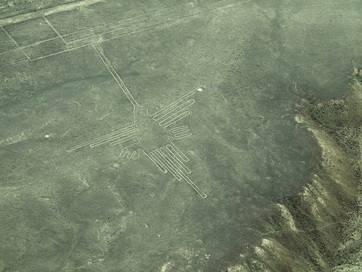 another geoglyph - the hummingbird another geoglyph - the hummingbird Near the southern coast of Peru and surrounded by a Martian desert landscape, at first glance there really wouldn’t be anything special about the place. Speeding by along the Southern Pan-American Highway, you’d only really feel compelled to stop to refill or gas or for food. Hiking atop the nearby hills or flying overhead, however, you’d quickly realize that there’s much more to Nazca than meets the ground-level eye: covering an area of almost a hundred square kilometers of the desert plateau to the west of Nazca are a collection of lines, figures, and shapes drawn into the sand as if by a giant finger into the dust of a giant windshield. Created by the Nazca people between 400 and 650 A.D., some of these shapes represent animals common to the area (spiders, monkeys, fish, birds) – others, however, are simply massive geometric figures that have no apparent meaning, though there are a few theories floating around… 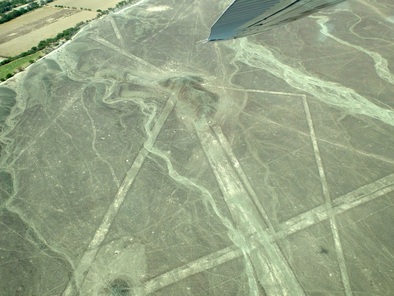 some more Nazca lines - what do they mean? some more Nazca lines - what do they mean? Of all the mystery surrounding the Nazca lines, the “how” is actually quite easy. A thin layer of reddish-brown pebbles covers most of the plateau – by removing this layer (typically between 10 and 15cm worth of debris) the much whiter layer of clay beneath is exposed. All you’d need is a few assertive mathematicians and enough strong backs to do the work, and presto – Nazca lines. The bigger question here is obviously, “Why?”. Why dedicate so much time and effort into creating something that can’t truly be appreciated by any of the people responsible for creating it?
|